Interview: Adrian Regnier | Mexico City
Based in Mexico City, Adrian Regnier is a multidisciplinary artist with his head firmly in the clouds. Obsessed by the celestial, Regnier creates works and worlds that are somehow familiar in their fantastical reach and impossibly probable in their physical construction, much like the cosmos themselves. His practice is most recently attuned to video and computer animation—his video piece, V.I.S.A., was awarded first prize at EAS's juried exhibition Translations this February—and often results in series or suites that explore preexisting systems and patterns—be they interstellar or man-made or somewhere in between—while building their own. La Fuga is a seemingly comprehensive suite of videos, comprised of 3D-animation, stock footage, stop-motion, infographics, explosions, and more, detailing lost love, lost life, pre-human history, and a post-apocalyptic future; the variety of formal techniques and thematic concerns is certainly impressive, and Regnier's view of the creative process, both his own and that of the universe at large, is ever expansive.
B. by Adrián Regnier. View more videos from Regnier's La Fuga series here.
I’ve recently been looking at La Fuga and all of its many parts; could you generally speak to the origin of a piece and series like this?
Ever since I can remember, both art and science have equally fascinated me with their mutually complementary capabilities of describing the world around us. When the time came to choose a career, I was equally interested in studying visual arts and/or physics, though my long-time relationship with drawing determined an otherwise very close call. Throughout my education at the National School of Painting, Sculpture and Engraving ‘La Esmeralda’, not only did my career as a drawing-based artist come to a much needed hiatus, but the contemporary art profile of the alumni sparked a new sense of integral conception in my artistic practice. It was in those years—late 2011, early 2012—that La Fuga slowly came to be.
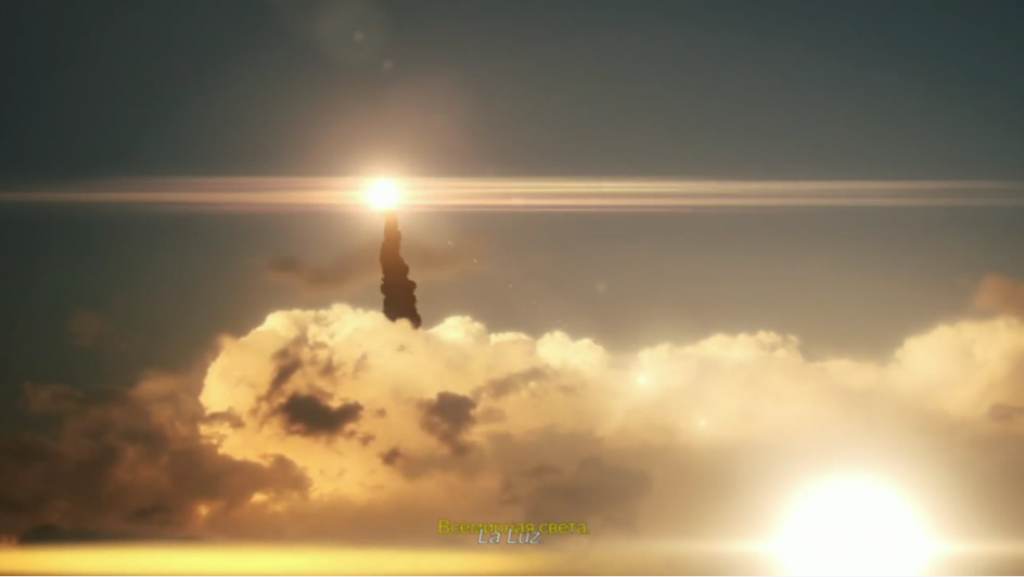
Did you initially conceive of it as a series, as multiple videos?
Curiously enough, La Fuga did not originate as a video complex, nor did I refer to it by that name, either. I remember one particular morning: just after I had finished my daily jogging routine, along came a lost memory of me as a kid simply laying in the grass and gazing at the clouds. I was immediately struck: “How long had humanity been evolving, growing and transforming below this ever-familiar mantel of nebular entities? How different would our history be remembered if as seen from outside our celestial margins?” And so I set to describe the nature of clouds and humanity as if equivalent—in the form of a bestiary of clouds. This marked the origins of one of the most characteristic trademarks of the project: the alphabetically-serialized portions of the project.
For this bestiary of clouds, I produced several achromatic, carbon-based drawings that individually illustrated 26 different ‘specimens’ or types of clouds. The idea was that in the almost-scientific representation of their shape and anatomy (deeply influenced by the aesthetics of the Voynich Manuscript or da Vinci’s body works, for example) I would adequately convey the uncanny similitudes between the clouds and humans: both definite in any given moment’s form, though ever-changing, shaped by the same natural forces and principles.
At the same time, I began experimenting with Adobe After Effects. These very basic initiations in a software primarily used for visual effects in modern films made evident another life-long fascination of mine: explosions and flashes, post-apocalyptic scenery, and end-of-the-worldly fear of the masses.
H. by Adrián Regnier. View more videos from Regnier's La Fuga series here.
To me the animations read as lost transmissions of sensitive material, though to and from whom is ambiguous. I think the music and sound effects are particularly effective in creating this feeling. Were the soundscapes created/composed specifically for this, or were they found?
At the beginning—and as any art student who wouldn’t know better at the time—I used non-licensed tracks for the first videos. When they started to gain visibility, though, I started tinkering with basic audio software, and so I gradually replaced those tracks with my own work. To this day I still sometimes do so. However, as my ideas grew and became much more complex and specific in the feeling I wished them to instill, I reached out into the world of artistic collaboration. This marked an important point in my artistic development, as I have always done the entirety of the visual work behind my videos—concept, art design, storyboarding, asset creating, animating, editing, and the world of work behind postproduction and final detailing.
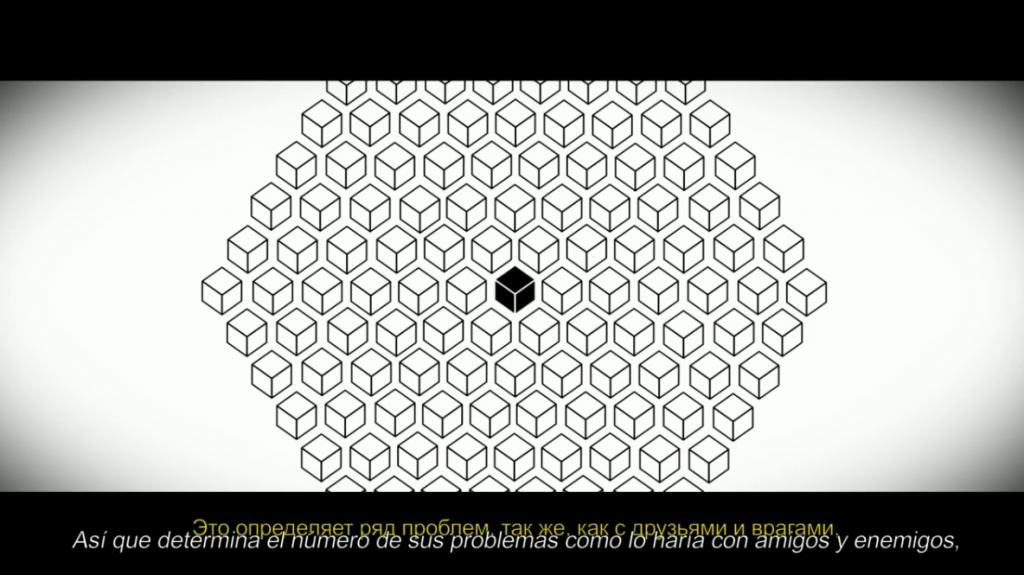
When the time came to acknowledge that my basic audio editing abilities would leave my works coming up short in the ‘suspension-of-disbelief’ department, I was lucky enough to find in my childhood’s friendships the marvelous vision and talent, Pablo Mariña Montalvo, my dearest composer and friend.[1] We started collaborating in 2012 when he ‘remastered’ B. by specifically composing an audio track for it. Since then, we’ve joined forces in the realization of I. (2014) and, perhaps most importantly, with my project Celeste[2] – Multiple Interpretation of The Stellar Order.
I’m similarly interested in the origin of the script and the resulting narration—did you write and record all the text? How did you decide which language to a. record in and b. show transcribed/translated on screen? What role does language play in the series, particularly the use of different languages, often overlapping?
From day one it has been my mad-rambling and exercise in literal absurdity that has voiced La Fuga—through the various use of words and symbols, in as many as nine different languages at once. For lack of a better order, I tend to leave the writing as the last, most delicious moments that crown each video. I do so in the proudest example of haphazard execution and experimental art direction—and it often drastically changes what each piece will turn into.
Formally speaking, what you listen to is always what is seen as subtitles or other forms of textual representation. In the very first video works (think B., K., P., etc.), the prevalence of Russian voices and yellow-tinted Cyrillic versions of the text served so as to introduce one of the thematic referential axes of the project: a soviet, cold war-esque feel and aesthetic that would point to the nuclear escalation aspect of La Fuga.
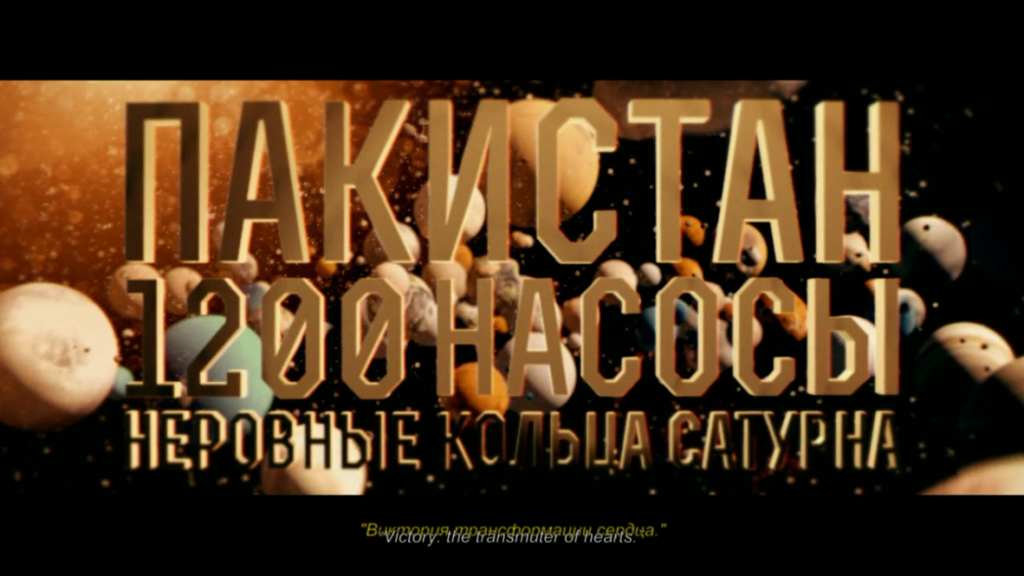
O. (2012) presents us with the ultimate cogs behind this doomsday device: the Nine Nuclear Nations. O. remains as an inflexion point for the visual, thematic and investigative processes that nurtured this ever-growing monstrosity, yes; but perhaps what is most interesting about it is the global, mapped tangibility of the realities it lent to La Fuga. What you will hear on works from that date forward, come voiced in one—or more!—of the eight (nine, plus my Latin-American audience’s Spanish) mother tongues: English, for the U.S.A. and the U.K.; Russian, for Russia ; Chinese, for China; Hindi, for India; Urdu, for Pakistan; Hebrew, for Israel; French, for France; and lastly, Korean, for North Korea. As their collective title may hint to, these nine countries are the only ones that, since the second half of the twentieth century, have produced, traded with, tested or used nuclear arms. Together they have amassed more than ten thousand of these earth-cloudifying bombs.
The best example of the importance of language in La Fuga comes in how H. (2014) strives to interweave each of these countries’ national anthems and mottos into a cosmic dialogue voiced in their native tongues. I like to present their messages’ importance as equivalent in hierarchy, and, when listened to synchronously, this more often than not merges them into a guttural cacophony that is sure to remind many of the Tower of Babel.
Not to sound too morbid, but it seems you find something conceptually compelling, or interesting, or challenging, about nuclear proliferation and the mutually assured destruction it entails—does that ring true? This series is not, to my mind, perhaps just a warning about annihilation, but reflective of other ideas about our (mankind’s) conceptions of ourselves and our world. How do you think our obsession for and history with nuclear arms and warfare affects or is representative of our relationship to our earth? Our universe? Each other?
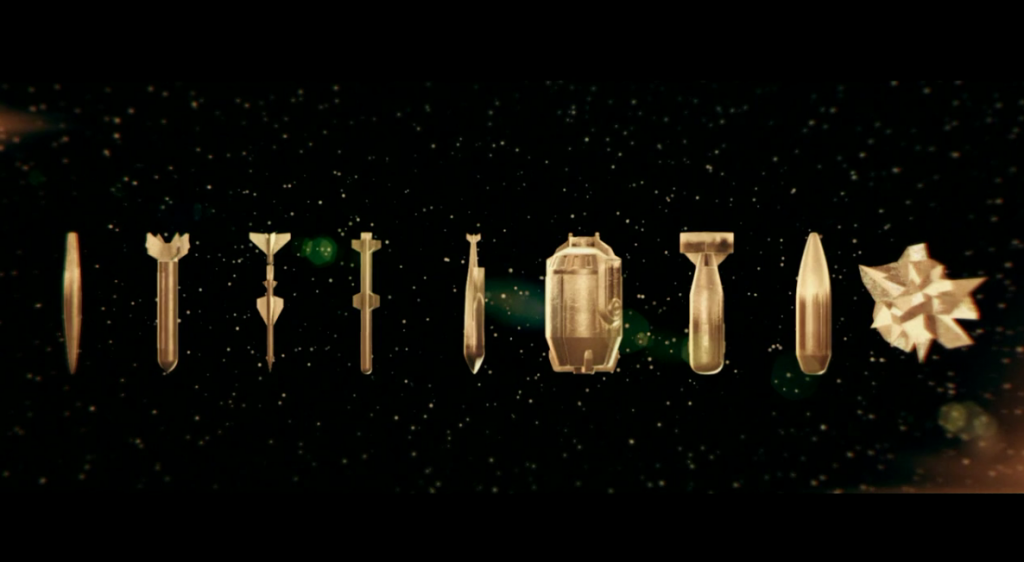
As I mentioned briefly a couple of questions back, as an author I prefer the grayer areas of the spectrum, rather than its extremes. In this sense, I concur with you—I do find all of this deeply compelling, interesting, challenging and dare I add, enlightening. In dealing with these themes, rather than fear of death and fiery destruction coming over me, its investigation comes with an uncanny—almost relaxing—sense of disproportionate belonging. I used the phrase ‘doomsday device’, and referred to the NNN’s as the primordial cogs of its orderly mechanisms with a purpose: theirs is a sort of unstoppable force comprised of immovable objects. The cultural, geopolitical, economic and military processes Human History springs from and returns to are so fundamentally complex that the absolute value it reflects in our lives may be described very simply: akin to how a nearly infinite number of molecular Brownian collisions dictate the sea’s natural cycles and geological patterns, we’d rather just simply say its tide ‘falls’ or ‘rises,’ the waves ‘come’ and ‘go’. The name we have given to these methods and processes you’ve called ‘nuclear arms’ and ‘warfare’ but in reality they are just some things going somewhere they weren’t before, and the energy behind said movements following the same paths.
I’d rather go the way thermoeconomics has taught me, in that humanity and all its empresses—from the most lovable and altruistic, to the lowest and vilest—can be described in any temporal tense by fluxes in energy and matter (i.e., allocation of resources, varying degrees of energy concentration and the factors that discreetly determine those both) on the surface of Earth. This conception and definition is consistent with and abides by the rules of physics and math, who together compile every major human breakthrough in the understanding of the universe.
I find myself finding comfort and happiness in these facts. And not in the ‘surrender yourself to a greater power’ kind of way, but in ‘it’s the natural rule of thermodynamic flux of entropy’ sense.The relaxing thing about La Fuga is that it describes things as they DO happen. Measured in violent bursts of nuclear megatons or along the course of humanity and its lifetime—it eventually all comes back together into order and newfound arrays of cosmos and disorder. Beauty is easy to find amidst that type of calm.
U. by Adrián Regnier. View more videos from Regnier's La Fuga series here.
From your physics-based take on nuclear destruction and creation the subject is beautifully, practically depoliticized, but the introduction of the Nine Nuclear Nations and the data provided about them brings us back to Earth, as it were, and our geo-political realities. Just from watching, and now from reading your thoughts, I see there’s not a message or a political stance but how do you reconcile such a heavy, topical issue with art-making?
Far from my work and the artistic circles and life it entails, I find myself continuously wondering about death. It has always frightened me—the egotistical ceasing of myself it will eventually entail. Yet the most soothing words about life and death have come from men and women of science—my mother, my teachers, my friends and colleagues. They speak of common origins and endings, doing so with the key concept of ‘transformation’. I’ve come to see life through this concept; it is very philosophically enticing to me. Change seems to seep into our lives and ooze freely from it.
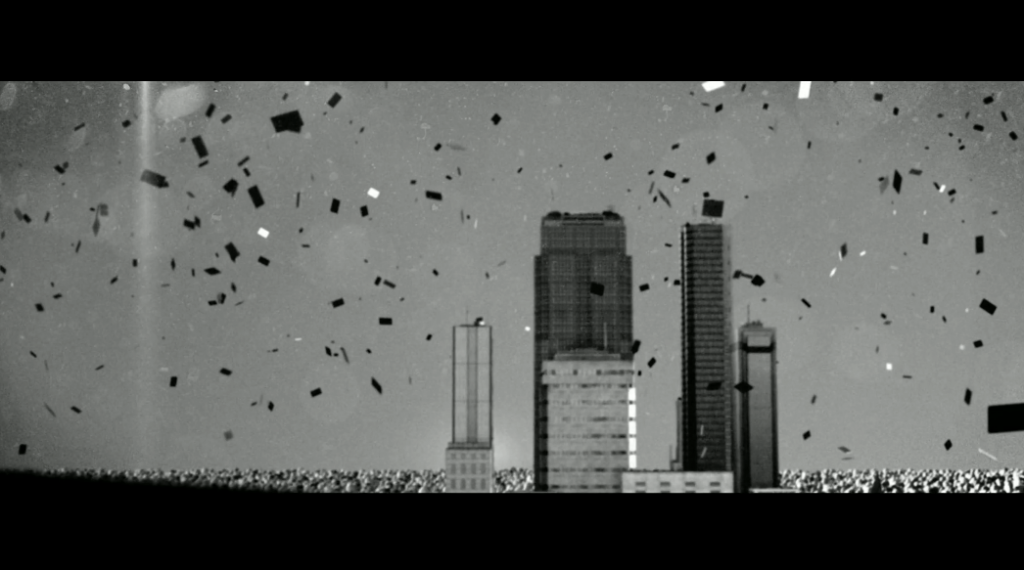
La Fuga is just one of these various forms that reduction ad absurdum has taken this time around. It is de-politicizing by absurdity; it is a cacophonous reverberation of the sounds and shapes we insist on making. In its de-patternization by repetition, I wish to allude to the same concepts and relationships we keep coming to.
There’s a common saying, that ‘death is the great equalizer’. I concur with it, though perhaps in the paraphrased version, which I think is more correct: Change is the great equalizer.
How does working with video and animation serve your interests as an artist? Do you work with other media?
As I shared with you earlier, I did not ‘plan’ nor see myself making a living out of video, but rather I saw myself as a traditional, physical medium based artist. Many events—both external and internal ones—coalesced into me discovering After Effects, through which I discovered how much video had to offer.
I wouldn’t only say what I do is animation. Both my concepts and techniques are widely borrowed from a number of areas I’ve been fortunate enough to coexist and mingle with in the process. As it stands, my video production has been showcased in animation festivals, but also experimental film and video ones, with me never being quite sure where its ‘absolute value’ stands. I’ve come to understand this flexibility much more as an aspect of versatility of the medium, rather than a defining—perhaps binding—aspect of my work. This trends to another important element that further cemented my migration into video—its mercurial, almost instantaneous way of sharing. I am a ravenous grant, fellowship, and open-call go-getter: the amount and type of opportunities video makes possible (by lending itself to easy online-viewing and sending via the internet, for example) are enormous in comparison to those where the physical sending of works may impose yet another hoop through which to jump in order to share my work.
This ‘volatilization’ in video’s sharing metabolism is key to one of the most important aspects of art for me: its capability to bring people together and spread specific notions through their life and words. We live in an era marked by the screens around us and the various reflections of ourselves they lend to us; our relationship with visual culture is advancing vertiginously fast.
V.I.S.A. by Adrián Regnier Chávez
Your piece for the recent EAS show, V.I.S.A., was all about US immigration practices and its psychological effects, simultaneously intimidating and tedious—can work about a government or state of affairs be non-political?
Sure it can. First of all, I think that this ‘non-political’ nature is multi-faceted: not only its construction, but its viewing, formatting, distribution—and the many other ways it has of developing over time—all add to the absolute value a work has. As you may infer, V.I.S.A. is not political to me in the sense that it meets the viewer with the U.S. flag. Yes, it has to do with the fact that, hadn’t I had the need to travel to Miami some months later, I wouldn’t have interfaced with another country, and confronted its political definition. But that’s pretty much where V.I.S.A. stopped addressing international agendas, and rather prompted me towards how absurd most of these questions were.
Politics are often an over-simplification of ever-complex realities. I propose what in essence makes of V.I.S.A. a Turing-esque dispositive: it takes political gesture, extends it to the highest n-degree of consequence and sees if its viewers remain only viewers afterwards. Any topic can grow out of its bounds when taken itself too seriously; I find most of what happens beyond these limits deeply fascinating. When you take any nation’s name and subject it to its most literal iteration, the patterns and tendencies behind even the subtlest of its intentions rise to the surface. Any number of stars and stripes becomes insignificant; language and phrasing are just commodities in the exercise of a more direct kind of intellectual content.
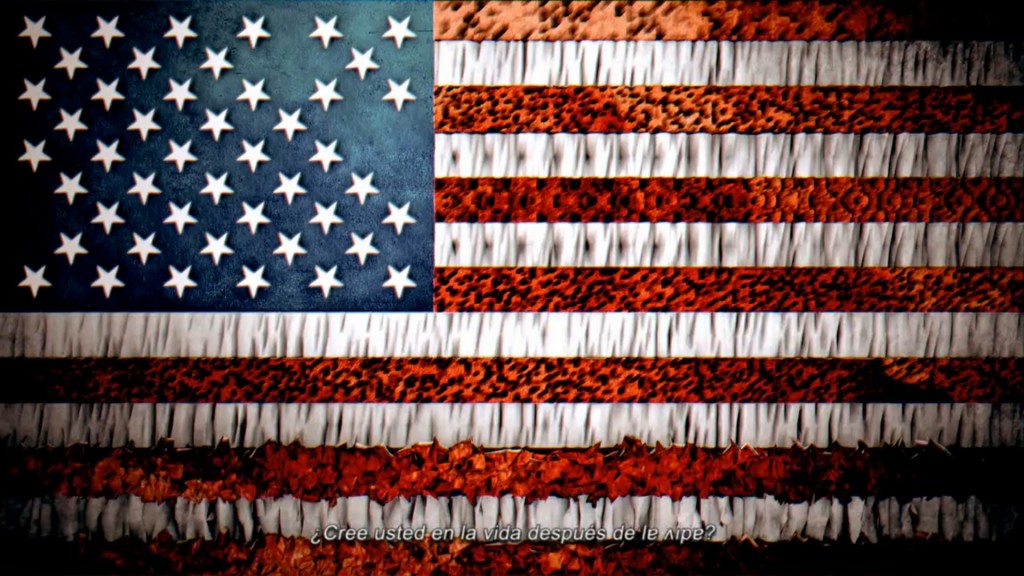
You are currently based in Mexico City—how long have you been there? What about the city suits your practice? How does the city serve young artists and vice versa?
I’ve lived here all of my life, and I love it. A big issue with art and culture in Mexico is de-centralization of resources and opportunities for places other than its capital (Mexico City). This is not to say that there aren’t an impressive amount of initiatives all around this enormous, rich country. I’ve been fortunate enough to share with many of my peers these past couple of years[1] and this has broadened my view of what is not only possible, but already being made by numerous, often over-lapping generations of creators.
As it stands, we’re amidst a series of political/cultural transitions that have been particularly aggressive in the cutting of federal funds for culture and arts. These impacts come in quick and rapid succession, and have many times negatively affected numerous ideas, startups, and projects that otherwise would have enjoyed that extra financial breathing room. But we know better than to give in to materialistic fear, and that is an amazing aspect of the artistic community—not only in Mexico, but I’d like to believe, a worldwide-resiliency.
Notes:
1. I would love to direct you to his online presence for everyone to enjoy his work, but he’s rather secretive in his artistic endeavors –luckily not with the ones that pertain to La Fuga.
2. Awarded the prestigious Grants & Commissions Program fellowship by the Cisnero Fontanals Art Foundation, in 2013 and 2014. You will find Celeste transmuted and re-assimilated into La Fuga’s mythology, as M., and @ multipleinterpretationofthestellarorder.com
3. Through an amazing opportunity and experience: the Young Creators fellowship, by the National Fund for Culture and Arts (Jóvenes Creadores 2013-2014 – FONCA, a federal initiative)
View Adrián Regnier's EAS profile here.